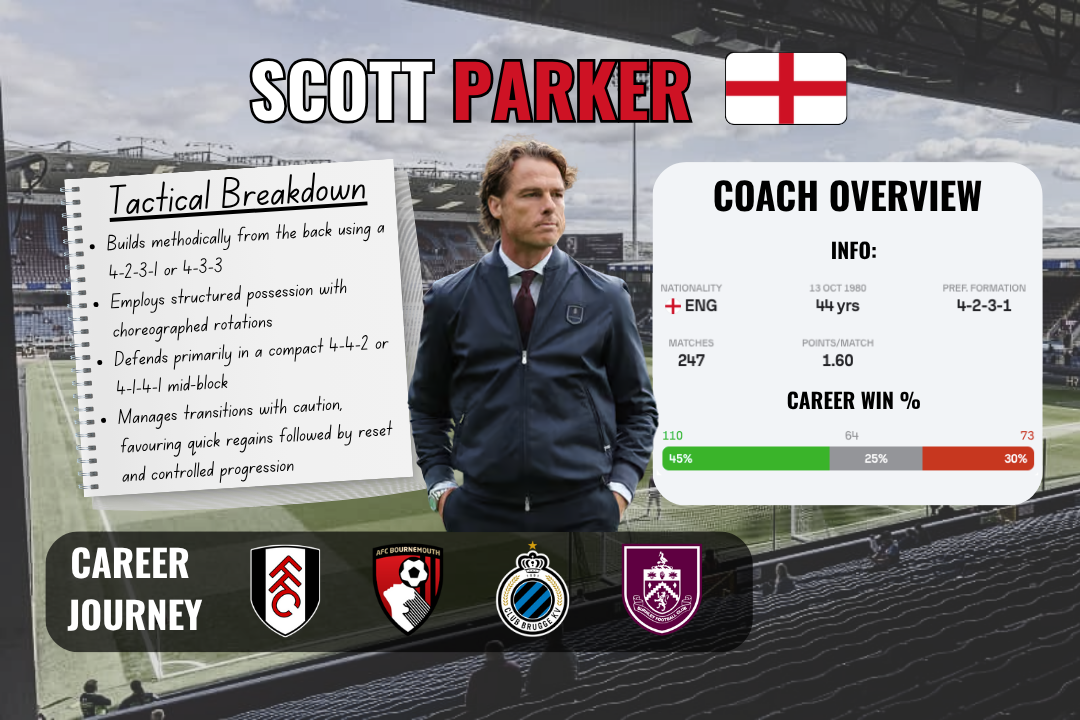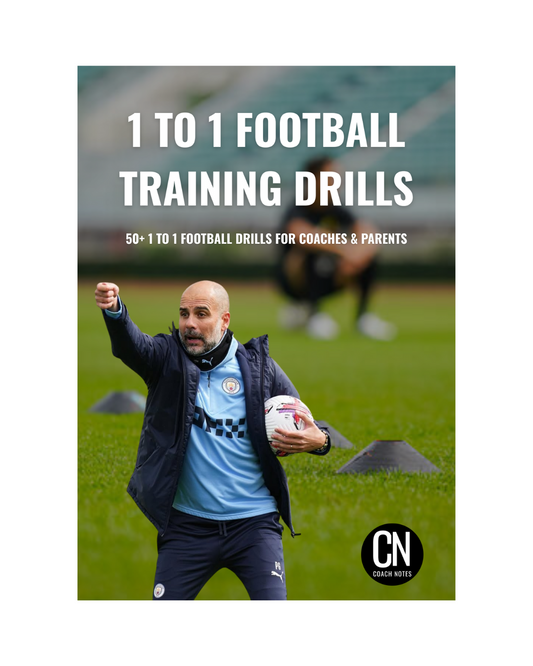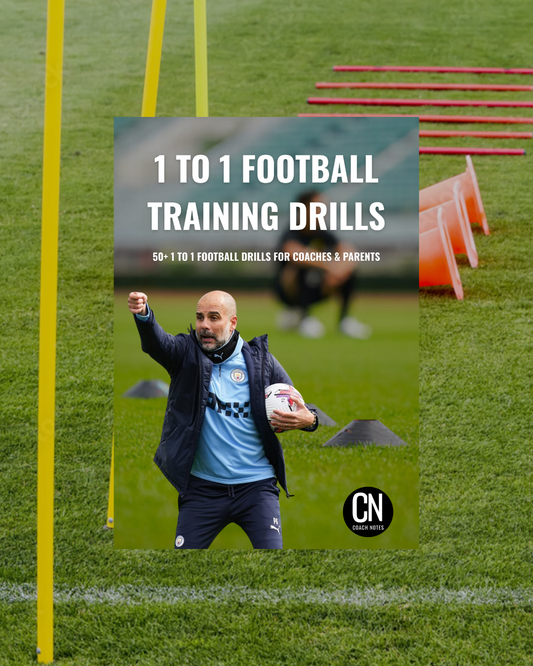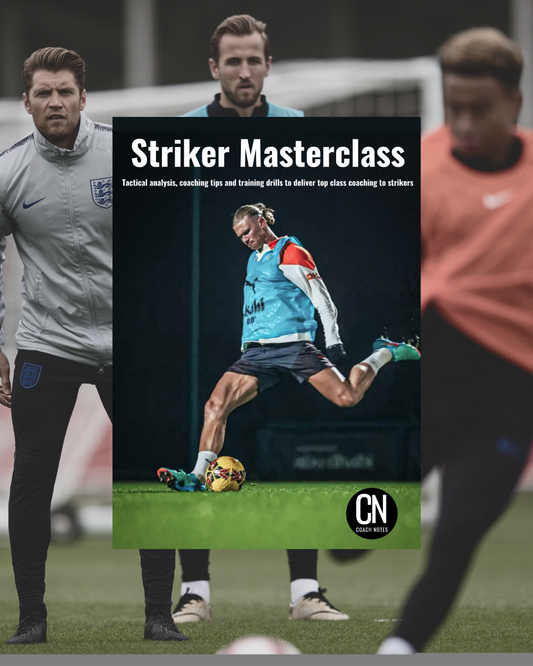
Scott Parker
Share
👤 Coach Bio
Scott Parker emerged from the Premier League’s coaching ranks as a manager with clear principles and modern ideas. A former England international midfielder, Parker played for clubs such as Charlton, Chelsea, Newcastle, West Ham, and Spurs. His playing career, marked by work ethic and leadership, transitioned naturally into coaching.
He began as a coach within Tottenham’s youth setup before moving to Fulham, where he quickly progressed from first-team coach to caretaker and eventually permanent manager. Parker led Fulham to Premier League promotion via the 2019–20 Championship play-offs, and later did the same with Bournemouth in 2021–22 by securing automatic promotion.
He had a short stint at Club Brugge in Belgium, where despite a challenging spell, he gained valuable European experience. Parker is a coach who believes in controlling matches, instilling discipline, and executing a structured playing style with clear positional demands.
⚽️ Playing Philosophy
Scott Parker’s footballing philosophy is built on structured possession, defensive compactness, and methodical build-up play. He values control, not necessarily in terms of dominating possession stats, but in dictating tempo and managing space effectively.
He encourages his teams to play through the thirds, with a focus on progression and positional discipline. Players are expected to maintain clear roles in and out of possession, with rotation and creativity emerging from structure rather than improvisation.
Parker's teams are typically well-drilled, with a tactical focus on shape, balance, and clean execution over flamboyance. He blends pragmatism with principles, tailoring his tactics to the context of each league and opponent.
🔍 Style of Play
In Possession
Parker prefers a 4-2-3-1 or 4-3-3 base shape, using positional play to create progressive build-ups through the lines.
- Build-up: Often begins with short passes from the back. Centre-backs split wide, the pivot drops between them, and full-backs provide width or drop deeper to support. He encourages patience in build-up, drawing the press before playing through it.
- Midfield Control: The double pivot is key. One sits to shield and recycle, while the other supports vertical progression. Midfielders rotate into half-spaces to open central lanes.
- Final Third Play: Wingers often invert to support combination play inside, while full-backs overlap. The No. 10 plays a vital linking role, acting as a creative hub.
- Attacking Patterns: Parker’s teams use choreographed movements – third-man runs, overloads on one side, and switches to the opposite flank are commonly rehearsed.
Although Parker’s sides are not free-flowing in the traditional sense, their possession is calculated and designed to unpick compact defences through sustained pressure.
Out of Possession
Parker’s defensive setups are organised and compact, typically in a 4-4-2 or 4-1-4-1 shape.
- Mid-Block Focus: His teams are most comfortable defending in a mid-block, where they can maintain structure and protect central areas.
- Pressing Triggers: He uses selective pressing – often initiating pressure on backward passes or poor first touches in wide areas.
- Zonal Integrity: Players hold their zones well. Rather than high-intensity counter-pressing, Parker relies on team shape and numbers behind the ball to nullify threats.
Against stronger teams, he adapts with deeper blocks, especially in the Premier League, prioritising resilience over aggression.
Transitional Moments
Parker is cautious with transitions, he values retention before risk.
- Attacking Transitions: His teams do not always break with pace but instead look for control after regaining possession. They reset quickly into structure before launching a more measured attack.
- Defensive Transitions: Players are coached to recover into their defensive block swiftly rather than gamble on immediate pressure. The nearest player may engage the ball carrier, but the emphasis is on restoring shape.
This approach reduces exposure and aligns with his overall philosophy of calculated control.
🧠 How to Coach Like Scott Parker
Scott Parker’s coaching method is systematic and detail-oriented. He builds team understanding through clear repetition, phase-specific drills, and tactical walkthroughs.
- Training Methodology: Sessions are often phase-based, focusing on build-up play, middle-third combinations, or final-third penetration separately before linking them together.
- Coaching Detail: Parker often stops play to coach positioning and decision-making. He focuses on receiving angles, timing of passes, and synchronised movement.
- Video Analysis: He leans heavily on video to reinforce tactical understanding, using clips to show positioning errors, structural successes, and attacking sequences.
- Match Preparation: His staff deliver opponent-specific plans, often adapting press intensity, full-back roles, or midfield setups based on analysis.
Aspiring coaches can learn from Parker’s emphasis on detail, game planning, and the clarity he provides to players in terms of their positional responsibilities.
👥 Player Profiles
Parker builds teams with discipline and structure in mind. He values functional, intelligent players who can execute roles consistently.
- Centre-Backs: Must be calm in possession, capable of splitting wide and passing progressively under pressure.
- Full-Backs: Expected to provide width in possession and defensive solidity. Depending on the opponent, they may invert or stay deep.
- Midfielders: Typically include a sitter and a progressive partner. Both must be composed under pressure and tactically astute.
- Wingers: Parker prefers wide players who can cut inside, combine centrally, or attack the byline depending on the game plan.
- Striker: Often a complete forward who can hold up play, link with the No. 10, and press intelligently when out of possession.
He doesn’t chase flair for flair’s sake, Parker prioritises reliability, discipline, and adaptability.
🔑 Key Takeaways for Coaches
- Control through structure – build a possession game that manages risk and tempo without sacrificing control.
- Mid-block mastery – understand how to coach compact out-of-possession shapes that protect central spaces and guide play wide.
- Use transitional patience – train your team to recover shape before launching counterattacks to maintain balance.
- Drill tactical roles repeatedly – ensure players understand their function in every phase through clear repetition and film review.
- Prioritise team discipline – Parker’s teams reflect his consistency and commitment to tactical organisation.









